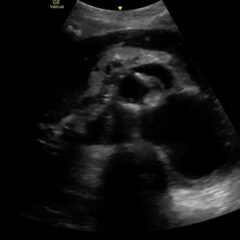Acute Chest Syndrome
ABSTRACT:
Audience:
Emergency medicine residents and medical students on emergency medicine rotations
Introduction:
Acute chest syndrome is a life-threatening, potentially catastrophic complication of sickle cell disease.1,2 It occurs in approximately 50% of patients with sickle cell disease, with up to 13% all-cause mortality.1 Most common in children aged 2-4, up to 80% of patients with a prior diagnosis of acute chest syndrome will have recurrence of this syndrome.4 Diagnostic criteria include a new infiltrate on pulmonaryimaging combined with any of the following: fever > 38.5°C (101.3°F), cough, wheezing, hypoxemia (PaO2 < 60 mm Hg), tachypnea, or chest pain.4,5 The pathophysiology of acute chest syndrome involves vaso-occlusion in pulmonary vessels resulting in hypoxia, release of inflammatory mediators, acidosis, and infarction of lung tissue. The most common precipitants are infections (viral or bacterial), rib infarction, and fat emboli.1,2,4 Patients commonly present with fever, dyspnea, cough, chills, chest pain, or hemoptysis. Diagnosis is made through physical exam, blood work, and chest imaging.1,2 Chest radiograph is considered the gold standard for imaging modality.3 Management of acute chest syndrome includes hydration with IV crystalloid solutions, antibiotics, judicious analgesia, oxygen, and, in severe cases, transfusion.6 Emergency medicine practitioners should keep acute chest syndrome as a cannot miss, high consequence differential diagnosis for all patients with sickle cell disease presenting to the Emergency Department.
Educational Objectives:
At the end of this oral board session, examinees will: 1) demonstrate the ability to obtain a complete medical history; 2) demonstrate the ability to perform a detailed physical examination in a patient with respiratory distress; 3) identify a patient with respiratory distress and hypoxia and manage appropriately (administer oxygen, place patient on monitor); 4) investigate the broad differential diagnoses which include acute chest syndrome, pneumonia, acute coronary syndrome, acute congestive heart failure, acute aortic dissection and acute pulmonary embolism; 5) list the appropriate laboratory and imaging studies to differentiate acute chest syndrome from other diagnoses (complete blood count, comprehensive metabolic panel, brain natriuretic peptide (BNP), lactic acid, procalcitonin, EKG, troponin level, d-dimer, chest radiograph); 6) identify a patient with acute chest syndrome and manage appropriately (administer intravenous pain medications, administer antibiotics after obtaining blood cultures, emergent consultation with hematology) and 7) provide appropriate disposition to the intensive care unit after consultation with hematology.
Educational Methods:
This case is used as a method to assess learners’ ability to rapidly assess a patient in respiratory distress. The learner needs to address a limited differential diagnosis list while simultaneously stabilizing and treating the patient. The “patient” becomes an active participant in the case, with repeated requests for pain medication, and appropriate analgesic administration is required as a critical action. For faculty, this case is used to assist with periodic assessment of resident performance while in the emergency department (ED).
We use oral board testing as one additional tool to assess residents’ critical thinking, while still applying the pressure that is needed to pass the oral certification examination. Large groups of residents can be assessed in short periods of time without needing to “wait” for this particular patient presentation to be seen in the ED.
In this case, learners were assessed using a free online evaluation tool, Google forms. Multiple questions were written for each critical action, and the Google form served as the online evaluation and repository of this information. The critical actions of the case were then tied to Emergency Medicine Milestones, and the results were compiled for use during resident clinical competency evaluations. Residents were provided with immediate feedback of their performance and were also given their electronic evaluations when requested.
Research Methods:
To assess the strengths and weaknesses of the case, learners and instructors were given the opportunity to provide electronic feedback after the case was completed. Subsequent modifications were made based on the feedback provided. Additionally, learners answered written multiple-choice questions after the case to assess for retention of the material.
Results:
Senior and junior residents alike enjoyed the process of an oral board simulation as an alternative to a more formal lecture. Seniors also stated that they felt more confident with their ability to pass the oral certification examination after having gone through oral board testing while in residency. Overall, the case was rated relatively highly, with residents scoring the case as 4.3 ± 0.186, 95% confidence interval (1-5 Likert scale, 5 being excellent, n=53) after their assessment was completed.
Discussion:
Students and residents who participated in the oral board exam formatting found this to be preferable to a traditional lecture and enjoyed the learning environment. Faculty also found this type of participation to be more engaging and were pleased with the ability to perform high-stress assessments with low stakes. The content contained in the case is relevant to all emergency medicine trainees, and this formatting forces the learner to be an active participant in the learning session. The case is a good model for the high-stakes testing of the oral certification exam and is an effective way to test a resident’s ability to rapidly assess and manage a life-threatening condition in the ED.
Topics:
Sickle cell anemia, vaso-occlusive pain crisis, acute chest syndrome, hypoxia, pneumonia, sepsis.


